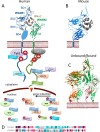The molecular basis for differential type I interferon signaling
- PMID: 28289098
- PMCID: PMC5418031
- DOI: 10.1074/jbc.R116.774562
The molecular basis for differential type I interferon signaling
Abstract
Type I interferons (IFN-1) are cytokines that affect the expression of thousands of genes, resulting in profound cellular changes. IFN-1 activates the cell by dimerizing its two-receptor chains, IFNAR1 and IFNAR2, which are expressed on all nucleated cells. Despite a similar mode of binding, the different IFN-1s activate a spectrum of activities. The causes for differential activation may stem from differences in IFN-1-binding affinity, duration of binding, number of surface receptors, induction of feedbacks, and cell type-specific variations. All together these will alter the signal that is transmitted from the extracellular domain inward. The intracellular domain binds, directly or indirectly, different effector proteins that transmit signals. The composition of effector molecules deviates between different cell types and tissues, inserting an additional level of complexity to the system. Moreover, IFN-1s do not act on their own, and clearly there is much cross-talk between the activated effector molecules by IFN-1 and other cytokines. The outcome generated by all of these factors (processing step) is an observed phenotype, which can be the transformation of the cell to an antiviral state, differentiation of the cell to a specific immune cell, senescence, apoptosis, and many more. IFN-1 activities can be divided into robust and tunable. Antiviral activity, which is stimulated by minute amounts of IFN-1 and is common to all cells, is termed robust. The other activities, which we term tunable, are cell type-specific and often require more stringent modes of activation. In this review, I summarize the current knowledge on the mode of activation and processing that is initiated by IFN-1, in perspective of the resulting phenotypes.
Keywords: STAT transcription factor; cell signaling; interferon; protein-protein interaction; receptor structure-function.
© 2017 by The American Society for Biochemistry and Molecular Biology, Inc.
Conflict of interest statement
The author declares that he has no conflicts of interest with the contents of this article
Figures



Similar articles
-
Herpes Simplex Virus 1 UL36USP Antagonizes Type I Interferon-Mediated Antiviral Innate Immunity.J Virol. 2018 Sep 12;92(19):e01161-18. doi: 10.1128/JVI.01161-18. Print 2018 Oct 1. J Virol. 2018. PMID: 29997210 Free PMC article.
-
Type I Interferon Signaling Is Decoupled from Specific Receptor Orientation through Lenient Requirements of the Transmembrane Domain.J Biol Chem. 2016 Feb 12;291(7):3371-84. doi: 10.1074/jbc.M115.686071. Epub 2015 Dec 17. J Biol Chem. 2016. PMID: 26679999 Free PMC article.
-
Intracellular interferons in fish: a unique means to combat viral infection.PLoS Pathog. 2013;9(11):e1003736. doi: 10.1371/journal.ppat.1003736. Epub 2013 Nov 14. PLoS Pathog. 2013. PMID: 24244163 Free PMC article.
-
Safety, Tolerability, and Immunogenicity of Interferons.Pharmaceuticals (Basel). 2010 Apr 20;3(4):1162-1186. doi: 10.3390/ph3041162. Pharmaceuticals (Basel). 2010. PMID: 27713294 Free PMC article. Review.
-
[Interferons: between structure and function].Postepy Hig Med Dosw (Online). 2014 May 6;68:428-40. doi: 10.5604/17322693.1101229. Postepy Hig Med Dosw (Online). 2014. PMID: 24864095 Review. Polish.
Cited by
-
Activation of plasmacytoid dendritic cells promotes AML-cell fratricide.Oncotarget. 2021 Apr 27;12(9):878-890. doi: 10.18632/oncotarget.27949. eCollection 2021 Apr 27. Oncotarget. 2021. PMID: 33953842 Free PMC article.
-
Conserved Induction of Distinct Antiviral Signalling Kinetics by Primate Interferon Lambda 4 Proteins.Front Immunol. 2021 Nov 18;12:772588. doi: 10.3389/fimmu.2021.772588. eCollection 2021. Front Immunol. 2021. PMID: 34868037 Free PMC article.
-
Decoding type I and III interferon signalling during viral infection.Nat Microbiol. 2019 Jun;4(6):914-924. doi: 10.1038/s41564-019-0421-x. Epub 2019 Apr 1. Nat Microbiol. 2019. PMID: 30936491 Free PMC article. Review.
-
TYK2 in Tumor Immunosurveillance.Cancers (Basel). 2020 Jan 8;12(1):150. doi: 10.3390/cancers12010150. Cancers (Basel). 2020. PMID: 31936322 Free PMC article. Review.
-
Signaling Crosstalk Mechanisms That May Fine-Tune Pathogen-Responsive NFκB.Front Immunol. 2019 Jul 2;10:433. doi: 10.3389/fimmu.2019.00433. eCollection 2019. Front Immunol. 2019. PMID: 31312197 Free PMC article. Review.
References
-
- Isaacs A., and Lindenmann J. (1957) Virus interference. I. The interferon. Proc. R Soc. Lond. B Biol. Sci. 147, 258–267 - PubMed
-
- Platanias L. C. (2005) Mechanisms of type-I- and type-II-interferon-mediated signalling. Nat. Rev. Immunol. 5, 375–386 - PubMed
-
- Krause C. D., and Pestka S. (2015) Cut, copy, move, delete: the study of human interferon genes reveal multiple mechanisms underlying their evolution in amniotes. Cytokine 76, 480–495 - PubMed
-
- Jaitin D. A., Roisman L. C., Jaks E., Gavutis M., Piehler J., Van der Heyden J., Uze G., and Schreiber G. (2006) Inquiring into the differential action of interferons (IFNs): an IFN-α2 mutant with enhanced affinity to IFNAR1 is functionally similar to IFN-β. Mol. Cell. Biol. 26, 1888–1897 - PMC - PubMed
Publication types
MeSH terms
Substances
Associated data
- Actions
- Actions
- Actions
- Actions
LinkOut - more resources
Full Text Sources
Other Literature Sources
Molecular Biology Databases

